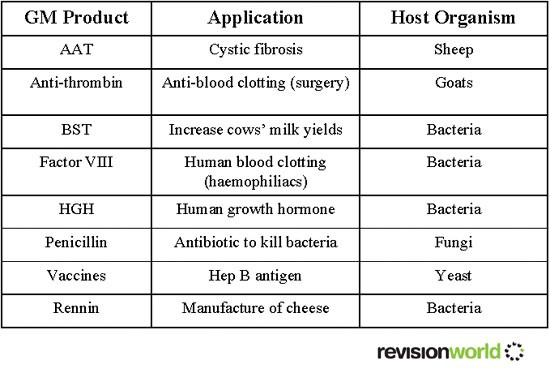Genetic Engineering
Gene Therapy is the altering the genotype of a tissue or organ
In early stages treatments hope to include:
- GM white blood cells that produce proteins that kill cancer cells
- targeting genes at cancer cells to kill them or revert them back to normal cells
- white blood cells that would not reproduce if infected with HIV
- germ-line modification (only present in animals) which is currently illegal
- at present, only somatic cell therapy is legal which alters only specific cells in the body
Applications of Gene Technology
3 main applications to date: -
1.Gene Products:
Using genetically modified (GM) organisms (usually microbes) to produce chemicals for medical or industrial applications

2. New Phenotypes:
Using gene technology to alter the characteristics of organisms such as crops
These include:
- Fast-growing sheep & fish
- Crops resistant to insects, herbicides & viruses
- Long life tomatoes & some fruit
- Crop improvement & nitrogen-fixing crops
- Cattle resistant to mastisis (> higher yield of milk)
- Sheep resistant to ticks (> may not need sheep dip)
3. Gene Therapy:
using gene technology on humans to treat diseases
Gene therapy and cystic fibrosis
This video provides an explanation of how gene theraphy can be used to treat genetic disorders such as cystic fibrosis
Genetic engineering and insulin production
Insulin is needed by the body to allow glucose to be taken up into the cells for use as fuel. Diabetes is a condition in which the pancreas does not produce enough insulin. Until 1982, insulin from oxen and pigs was used to treat the condition. Today genetically modified yeast is used to produce insulin that is identical to human insulin. The video below gives an introduction to genetic engineering and its use in the production of insulin.

